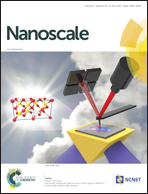Epitaxial magnetite nanorods with enhanced room temperature magnetic anisotropy†
Abstract
Nanostructured magnetic materials with well-defined magnetic anisotropy are very promising as building blocks in spintronic devices that operate at room temperature. Here we demonstrate the epitaxial growth of highly oriented Fe3O4 nanorods on a SrTiO3 substrate by hydrothermal synthesis without the use of a seed layer. The epitaxial nanorods showed biaxial magnetic anisotropy with an order of magnitude difference between the anisotropy field values of the easy and hard axes. Using a combination of conventional magnetometry, transverse susceptibility, magnetic force microscopy (MFM) and magneto-optic Kerr effect (MOKE) measurements, we investigate magnetic behavior such as temperature dependent magnetization and anisotropy, along with room temperature magnetic domain formation and its switching. The interplay of epitaxy and enhanced magnetic anisotropy at room temperature, with respect to randomly oriented powder Fe3O4 nanorods, is discussed. The results obtained identify epitaxial nanorods as useful materials for magnetic data storage and spintronic devices that necessitate tunable anisotropic properties with sharp magnetic switching phenomena.



 Please wait while we load your content...
Please wait while we load your content...